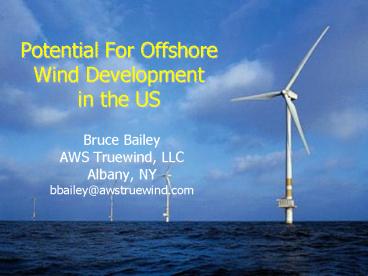Potential For Offshore Wind Development in the US - PowerPoint PPT Presentation
1 / 23
Title:
Potential For Offshore Wind Development in the US
Description:
Numerical weather models. High resolution wind maps. New Measurements. Site specific _at_ hub height ... Learn from European experiences. Recommended Resource ... – PowerPoint PPT presentation
Number of Views:43
Avg rating:3.0/5.0
Title: Potential For Offshore Wind Development in the US
1
Potential For Offshore Wind Development in
the US
- Bruce Bailey
- AWS Truewind, LLC
- Albany, NY
- bbailey_at_awstruewind.com
2
Why Wind Energy?
- Fastest growing energy source
- Costs dropped 90 in 20 years
- Growing demand/incentives for green energy
- Wind is lowest cost renewable and can generate
bulk power - Fuel price uncertainty (gas oil)
- Energy security
3
Why Go Offshore?
- No windy lands near many load centers in East
- Transmission barriers on land for long distances
- Can satisfy state clean power programs
- Its windier
Over 50 of population lives in coastal counties.
- Offshore wind can still be cheaper than other
land-based renewable sources
4
Existing Planned Offshore Projects in Northern
Europe
First Offshore Project Built in 1991 gt600 MW
Operating gt10,000 MW Planned
5
Europe Is Pioneering Offshore WindWhy?
- Aggressive government policies promoting green
energy - Widespread acceptance/familiarity with land-based
wind projects - Shallow waters well offshore
160 MW Horns Rev Project Off West Coast of Denmark
6
Offshore Wind Requirements
- Large projects improve economics
- Avg. winds gt18 mph (8 m/s)
- Shallow water depths, for now
- Avoid areas with excessive waves
- Avoid environmentally sensitive areas, shipping
lanes, etc. - Near transmission port
7
Offshore Challenges
- Corrosive, hostile environment
- Higher costs
- Difficult access
- New Infrastructure
- Long permitting construction schedule
- Inexperience
8
Offshore Components
- Turbines rated 2 - 4 MW
- Tower heights gt200 ft (60 m)
- Spaced 1/3 to ½ mile apart
- Rotor diameters of 250-350 ft
- Foundations
(monopile, tripod, gravity base) - Substation marine cable
- Port facilities
9
Technology Trends
- Transition from land-based modified designs to
custom offshore - Larger sizes (5-10 MW)
- Ultra-high reliability components
- Emphasis on safety/access issues
- Foundations for deep water
- Purpose-built vessels
- Hydrogen production?
10
(No Transcript)
11
(No Transcript)
12
New England Wind Power Class Map
- Commercial Land Wind Projects Require Class 4
Wind Class - Offshore Wind Projects Require Class 5 Due to
Higher Construction Costs
13
New England Water Depths
- All Offshore Projects Have Been Built in Waters
lt50 ft Deep - Some Proposed Offshore Projects Are In Waters 70
ft Deep - Deep-Water Foundation Designs Are Under
Development
14
New England Windy Areas
- Windy Lands (Class 4) With and Without
Parks/Govt. Forests - 28 of windy lands are in parks/govt. forests
- Windy Waters (Class 5) with depths lt70 ft
- 40 of windy waters beyond 3-mile limit
15
Mid-Atlantic Windy Areas
- Windy Lands (Class 4) With and Without
Parks/Govt. Forests - 42 of windy lands are in parks/govt. forests
- Windy Waters (Class 5) with depths lt70 ft
- 80 of windy waters beyond 3-mile limit
16
West Coast Windy Areas
75 of windy lands in parks/govt. forests
17
Available Windy Area
Class 4 on Land Class 5 Offshore and Water
Depths lt70 ft No land use exclusions
The U.S. Dept. of Energy estimates there to be
900 GW of offshore wind generation capacity, an
amount greater than the current installed U.S.
electrical capacity.
18
Required Wind Data For Offshore Siting Design
- Avg. Speeds annual, monthly, diurnal (at hub
height) - Speed Frequency Distribution
- Wind Shear
- Turbulence Intensity
- Wind Direction Rose
- Extreme Gusts Return Periods
- Coincident Sea-State Conditions
- Coincident Air Temperatures
- Coincident Ice Accretion
19
Sources of Resource Info
NASA-JPL
- Surface/Upper-Air
- Airports, CG stations, buoys (NOAA, NWS
NDBC) - Ships
- Commercial aircraft
- Weather balloons
- Remote Sensing
- Satellite
- Modeling/Mapping
- Numerical weather models
- High resolution wind maps
- New Measurements
- Site specific _at_ hub height
National Data Buoy Center
20
Load Matching of Offshore Wind
Much higher capacity credit ratings for offshore
wind than onshore because inland ridgetop winds
peak at night.
Avg. Peak Day1999-2003Coastal NJ Utility Load
Plant Net Capacity Factor
21
Conclusions
- Relatively shallow waters and large energy
appetite favor East coast for initial offshore
wind development - Barriers to overcome planning needed
- Offshore wind not well understood by
stakeholders need collaboration - Include offshore wind in the development of state
and federal energy policies - Learn from European experiences
22
Recommended Resource
A Framework for Offshore Wind Energy Development
in the United States www.masstech.org/offshore/
final_09_20.pdf
23
Other Resources
Long Island Power Authority Offshore
Project www.lioffshorewindenergy.org
www.capewind.org
www.offshorewindenergy.org































